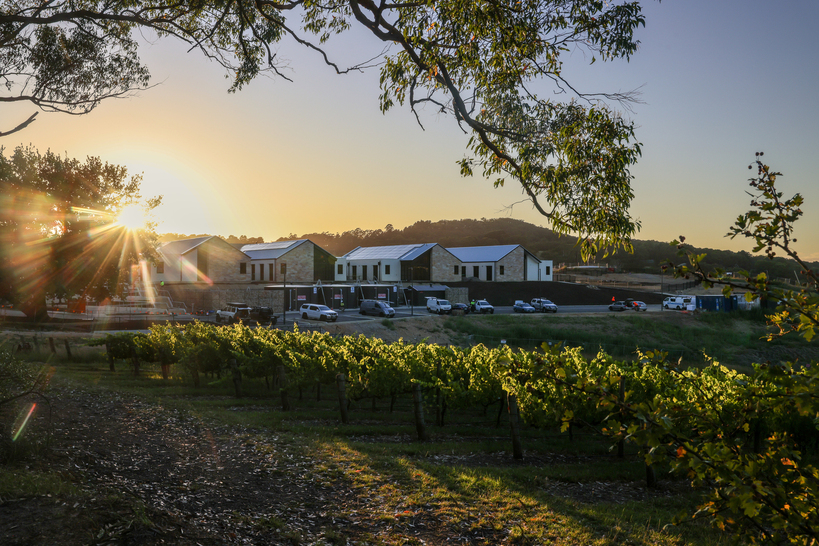
Featured articles from our Aged Care Today magazine authored by our Ageing Australia team and specialists within the aged care sector.
Complimenting the rolling hills and quiet township, the meticulously designed 60-bed aged care home is intentionally single-level and arranged as a small house model.
Each small home can cater for up to 10 people, including singles and couples, with ensuite bedrooms, lounge area and kitchen.
The eight individual homes are designed to look very much like private residences, with no hint of institutionalised living.
All homes are interconnected through a central area where communal spaces are located, including common activity areas, consulting rooms, dining rooms, a commercial kitchen, hairdresser and gymnasium.
Energy saving inclusions like solar power mean long-term reduced energy costs for the site and a smaller carbon footprint.
The stunning surrounds of vineyards, cherry orchards and hilltops cradling native vegetation informed the design aesthetic, which features natural elements and organic textures like extensive timber panelling and stonework.
Enormous skylights feature in the grand entry and reception area features, while throughout the entire build floor to ceiling windows allow connection with the outdoors with beautiful vistas.
At Summerhill, connectedness and community are strong themes.
“Most of our residents are from the Hills district and we wanted to make sure they remain engaged with their community both visually and in other ways,” said Jo Boylan, CEO of Clayton Church Homes and a former registered nurse with more than 20 years’ experience in executive leadership positions in aged care.
“Summerhill is really about a harmonious connection with the outdoors and the places our residents call home.
“Our staff are also from the local area which helps maintain a sense of closeness and togetherness.
“We’re currently developing our community engagement program to encourage more interaction between our residents and the wider community, because we now have some wonderful facilities we can offer to everyone.”
Ideas for community engagement include inviting volunteers to develop the garden, which has already been designed but elements like the vegetable garden still need to be planted, as well as connecting with artists.
The on-site gymnasium, café and hairdresser will be open to anyone, with the on-site exercise physiologist set to plan structured activities at the gymnasium for older people in the community who can utilise the facilities through their home care packages.
Catering for the whole person, Summerhill residents also benefit from regular visits from the local GP, while the local pharmacist will also have an important role to play, located only 200 metres away in the Uraidla village shopping district.
Local community-minded groups like Imagine Uraidla will be a source of ideas and further advancement of community engagement activities, while the on-site children’s playground will be a source of enjoyment for younger visitors.
“At Clayton Church Homes we’re very focused on providing high-quality services to the older people of South Australia,” said Jo.
“Summerhill is a testament to that, it’s both visually stunning and capable of meeting the needs of people as they age in a manner that is consistent with their way of life.
“It’s a community of gardeners, artists and foodies, and we aim to support that in everything we do.”
Summerhill was designed by Mario Dreosti, Managing Director of Brown Falconer architects in Adelaide and built by Kennett Builders, whose intricate attention to detail particularly the stonemasonry won them a Master Builders SA award in 2024.
Mario says the project was conceived as a village on a hill, with the design based on a comprehensive engagement process and a cultural mapping of the local context.
“An Adelaide Hills vernacular informed the building form and materiality and the potential to host pop up events, particularly celebrating a bread making history for both colonial settlers and earlier that of the Peramangk people who ground kangaroo grass seeds,” he said.
“This influenced the design of the multiple purpose space, alfresco dining and adjacent nature play area.
“The series of distinct ‘small houses’ are purposefully connected by a central main street spine which journeys through the public facing venue space to the productive gardens, gym, hairdresser and other common spaces.
“The architecture and the care model are founded on the principles of offering engagement and enablement in activities and pursuits which are connected to place and a sense of social context.”
Linda Baraciolli, Aged Care Today Editor,
ACCPA

Reach out to your state or territory manager
Australia’s leading aged services magazine distributed quarterly featuring informative articles from service providers, suppliers, innovators and thought leaders across aged the aged care sector.
To submit story suggestions, please contact the editor.
For magazine advertising rates, please view our media kit.

Ageing Australia acknowledges the Traditional Owners of Country throughout Australia and recognises their continuing connection to land, sea, waters and community.
We pay our respects to Aboriginal and Torres Strait Islander cultures, and to Elders past and present.